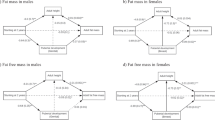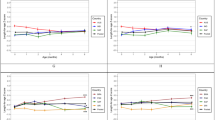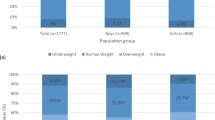Abstract
Background:
Early postnatal rapid ‘catch-up’ weight gain has been consistently associated with subsequent higher obesity risk and earlier pubertal development. In many low- and middle-income countries, infancy catch-up weight gain is transient and often followed by growth faltering. We explored the hypothesis that even transient catch-up weight gain during infancy is associated with later obesity risk and earlier puberty.
Methods:
A total of 2352 (1151 male, 1201 female) black South African children in the birth to twenty prospective birth cohort study (Johannesburg–Soweto) underwent serial measurements of body size and composition from birth to 18 years of age. At the age of 18 years, whole-body fat mass and fat-free mass were determined using dual-energy X-ray absorptiometry. Pubertal development was assessed by the research team between ages 9 and 10 years, and it was recorded annually from the age of 11 years using a validated self-assessment protocol.
Results:
Catch-up weight gain from birth to the age of 1 year, despite being followed by growth faltering between ages 1 and 2 years, was associated with greater mid-upper arm circumference (P=0.04) and skinfold thickness (P=0.048) at 8 years of age, and with higher weight (P<0.001) and body mass index (P=0.001) at 18 years of age after adjustment for sex, age, smoking during pregnancy, birth order, gestational age, formula-milk feeding and household socio-economic status. Infancy catch-up weight gain was also associated with younger age at menarche in girls (P<0.001). This association persisted after adjustment for smoking during pregnancy, birth order, gestational age, formula-milk feeding and household socio-economic status (P=0.005).
Conclusion:
Transient catch-up weight gain from birth to the age of 1 year among children born in a low-income area of South Africa was associated with earlier menarche and greater adiposity in early adulthood. This observation suggests that modifiable determinants of rapid infancy weight gain may be targeted in order to prevent later obesity and consequences of earlier puberty in girls.
This is a preview of subscription content, access via your institution
Access options
Subscribe to this journal
Receive 12 print issues and online access
$259.00 per year
only $21.58 per issue
Buy this article
- Purchase on Springer Link
- Instant access to full article PDF
Prices may be subject to local taxes which are calculated during checkout




Similar content being viewed by others
References
Law CM, Shiell AW, Newsome CA, Syddall HE, Shinebourne EA, Fayers PM et al. Fetal, infant, and childhood growth and adult blood pressure: a longitudinal study from birth to 22 years of age. Circulation 2002; 105: 1088–1092.
Reilly JJ, Methven E, McDowell ZC, Hacking B, Alexander D, Stewart L et al. Health consequences of obesity. Arch Dis Child 2003; 88: 748–752.
Wardle J, Brodersen NH, Cole TJ, Jarvis MJ, Boniface DR . Development of adiposity in adolescence: five year longitudinal study of an ethnically and socioeconomically diverse sample of young people in Britain. BMJ 2006; 332: 1130–1135.
Baker JL, Olsen LW, Sorensen TI . Childhood body-mass index and the risk of coronary heart disease in adulthood. N Engl J Med 2007; 357: 2329–2337.
Baird J, Fisher D, Lucas P, Kleijnen J, Roberts H, Law C . Being big or growing fast: systematic review of size and growth in infancy and later obesity. BMJ 2005; 331: 929.
Euser AM, Finken MJ, Keijzer-Veen MG, Hille ET, Wit JM, Dekker FW . Associations between prenatal and infancy weight gain and BMI, fat mass, and fat distribution in young adulthood: a prospective cohort study in males and females born very preterm. Am J Clin Nutr 2005; 81: 480–487.
Monteiro PO, Victora CG . Rapid growth in infancy and childhood and obesity in later life-a systematic review. Obes Rev: Offl J Int Assoc Study Obes 2005; 6: 143–154.
Ong KK, Loos RJ . Rapid infancy weight gain and subsequent obesity: systematic reviews and hopeful suggestions. Acta Paediatr 2006; 95: 904–908.
Bouhours-Nouet N, Dufresne S, de Casson FB, Mathieu E, Douay O, Gatelais F et al. High birth weight and early postnatal weight gain protect obese children and adolescents from truncal adiposity and insulin resistance: metabolically healthy but obese subjects? Diabetes Care 2008; 31: 1031–1036.
Garn SM, LaVelle M, Rosenberg KR, Hawthorne VM . Maturational timing as a factor in female fatness and obesity. Am J Clin Nutr 1986; 43: 879–883.
Helm P, Munster K, Schmidt L . Recalled menarche in relation to infertility and adult weight and height. Acta Obstet Gynecol Scand 1995; 74: 718–722.
van Lenthe FJ, Kemper CG, van Mechelen W . Rapid maturation in adolescence results in greater obesity in adulthood: the Amsterdam growth and health study. Am J Clin Nutr 1996; 64: 18–24.
Ong KK, Petry CJ, Emmett PM, Sandhu MS, Kiess W, Hales CN et al. Insulin sensitivity and secretion in normal children related to size at birth, postnatal growth, and plasma insulin-like growth factor-I levels. Diabetologia 2004; 47: 1064–1070.
Ahmed ML, Ong KK, Dunger DB . Childhood obesity and the timing of puberty. Trends Endocrinol Metab 2009; 20: 237–242.
Ong KK, Emmett P, Northstone K, Golding J, Rogers I, Ness AR et al. Infancy weight gain predicts childhood body fat and age at menarche in girls. J Clin Endocrinol Metab 2009; 94: 1527–1532.
Maisonet M, Christensen KY, Rubin C, Holmes A, Flanders WD, Heron J et al. Role of prenatal characteristics and early growth on pubertal attainment of British girls. Pediatrics 2010; 126: e591–e600.
Ong KK, Bann D, Wills AK, Ward K, Adams JE, Hardy R et al. Timing of voice breaking in males associated with growth and weight gain across the life course. J Clin Endocrinol Metab 2012; 97: 2844–2852.
Wang Y, Dinse GE, Rogan WJ . Birth weight, early weight gain and pubertal maturation: a longitudinal study. Pediatr Obes 2012; 7: 101–109.
Black RE, Allen LH, Bhutta ZA, Caulfield LE, de Onis M, Ezzati M et al. Maternal and child undernutrition: global and regional exposures and health consequences. Lancet 2008; 371: 243–260.
Victora CG, de Onis M, Hallal PC, Blossner M, Shrimpton R . Worldwide timing of growth faltering: revisiting implications for interventions. Pediatrics 2010; 125: e473–e480.
Prentice AM, Moore SE, Fulford AJ . Growth faltering in low-income countries. World Rev Nutr Dietetics 2013; 106: 90–99.
Richter LM, Norris SA, De Wet T . Transition from birth to ten to birth to twenty: the South African cohort reaches 13 years of age. Paediatr Perinat Epidemiol 2004; 18: 290–301.
Richter L, Norris S, Pettifor J, Yach D, Cameron N . Cohort profile: Mandela's children: the 1990 birth to twenty study in South Africa. Int J Epidemiol 2007; 36: 504–511.
Tanner JM . Growth at Adolescence. Blackwell Scientific Publications: Oxford, 1962.
Tanner JM . Standards of normal growth. In Tanner JM ed Foetus into Man: Physical Growth from Conception to Maturity. Open Books: London, 196–201 1978.
Norris SA, Richter LM . Application and validation of tanner pubertal self-rating to urban black adolescents in South Africa. J Adolesc Res 2005; 15: 609–624.
Ong KK, Ahmed ML, Emmett PM, Preece MA, Dunger DB . Association between postnatal catch-up growth and obesity in childhood: prospective cohort study. BMJ 2000; 320: 967–971.
Ekelund U, Ong KK, Linne Y, Neovius M, Brage S, Dunger DB et al. Association of weight gain in infancy and early childhood with metabolic risk in young adults. J Clin Endocrinol Metab 2007; 92: 98–103.
Leunissen RW, Kerkhof GF, Stijnen T, Hokken-Koelega A . Timing and tempo of first-year rapid growth in relation to cardiovascular and metabolic risk profile in early adulthood. JAMA 2009; 301: 2234–2242.
Chomtho S, Wells JC, Williams JE, Davies PS, Lucas A, Fewtrell MS . Infant growth and later body composition: evidence from the 4-component model. Am J Clin Nutr 2008; 87: 1776–1784.
Singhal A, Fewtrell M, Cole TJ, Lucas A . Low nutrient intake and early growth for later insulin resistance in adolescents born preterm. Lancet 2003; 361: 1089–1097.
Stettler N, Stallings VA, Troxel AB, Zhao J, Schinnar R, Nelson SE et al. Weight gain in the first week of life and overweight in adulthood: a cohort study of European American subjects fed infant formula. Circulation 2005; 111: 1897–1903.
McCance RA, Widdowson EM . The effects of chronic undernutrition and of total starvation on growing and adult rats. Brt J Nutr 1956; 10: 363–373.
Ong KK, Northstone K, Wells JC, Rubin C, Ness AR, Golding J et al. Earlier mother's age at menarche predicts rapid infancy growth and childhood obesity. PLoS medicine 2007; 4: e132.
Lakshman R, Forouhi N, Luben R, Bingham S, Khaw K, Wareham N et al. Association between age at menarche and risk of diabetes in adults: results from the EPIC-Norfolk cohort study. Diabetologia 2008; 51: 781–786.
Freedman DS, Khan LK, Serdula MK, Dietz WH, Srinivasan SR, Berenson GS . The relation of menarcheal age to obesity in childhood and adulthood: the Bogalusa heart study. BMC Pediatrics 2003; 3: 3.
Must A, Naumova EN, Phillips SM, Blum M, Dawson-Hughes B, Rand WM . Childhood overweight and maturational timing in the development of adult overweight and fatness: the Newton Girls Study and its follow-up. Pediatrics 2005; 116: 620–627.
Ong KK, Preece MA, Emmett PM, Ahmed ML, Dunger DB . Size at birth and early childhood growth in relation to maternal smoking, parity and infant breast-feeding: longitudinal birth cohort study and analysis. Pediatr Res 2002; 52: 863–867.
Acknowledgements
We are grateful to all study participants, their families and research assistants. Birth to twenty has been supported by The Wellcome Trust, Human Sciences Research Council, Medical Research Council, University of the Witwatersrand, the South African-Netherlands Programme on Alternative Development and the Anglo American Chairman’s Fund.
Author information
Authors and Affiliations
Corresponding author
Ethics declarations
Competing interests
The authors declare no conflict of interest.
Rights and permissions
About this article
Cite this article
Salgin, B., Norris, S., Prentice, P. et al. Even transient rapid infancy weight gain is associated with higher BMI in young adults and earlier menarche. Int J Obes 39, 939–944 (2015). https://doi.org/10.1038/ijo.2015.25
Received:
Revised:
Accepted:
Published:
Issue Date:
DOI: https://doi.org/10.1038/ijo.2015.25
This article is cited by
-
Effects of rapid growth on fasting insulin and insulin resistance: a system review and meta-analysis
European Journal of Clinical Nutrition (2021)
-
Unravelling the role of epigenetics in reproductive adaptations to early-life environment
Nature Reviews Endocrinology (2020)
-
Factors associated with early introduction of complementary feeding and consumption of non-recommended foods among Dutch infants: the BeeBOFT study
BMC Public Health (2019)
-
Sleep SAAF: a responsive parenting intervention to prevent excessive weight gain and obesity among African American infants
BMC Pediatrics (2019)
-
Infant Growth and Long-term Cardiometabolic Health: a Review of Recent Findings
Current Nutrition Reports (2019)



